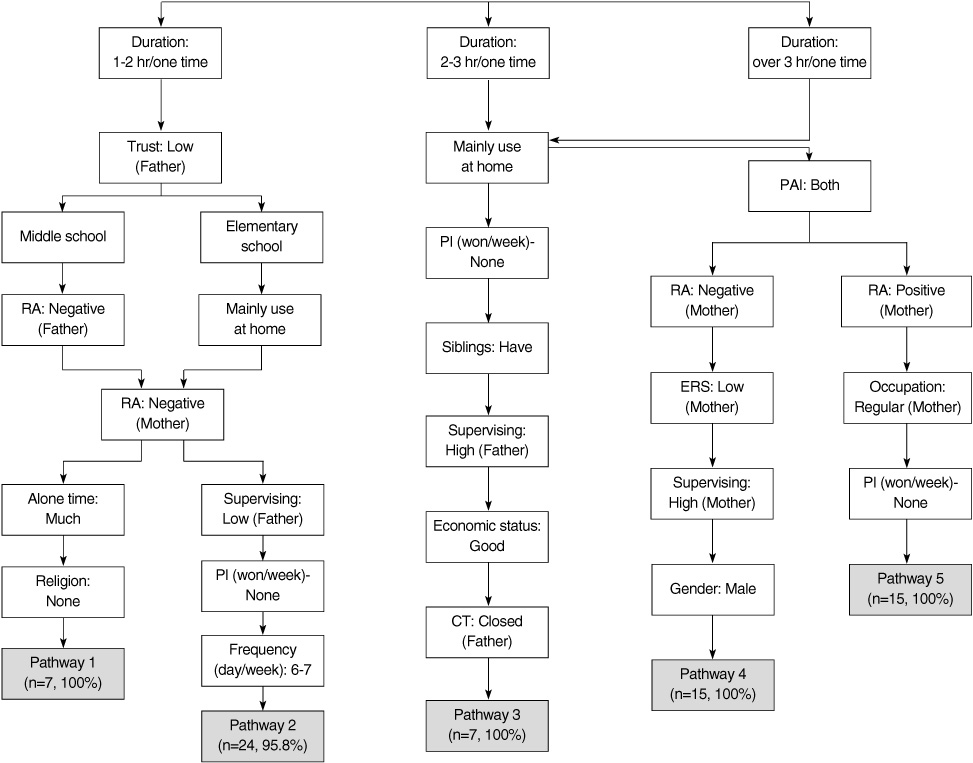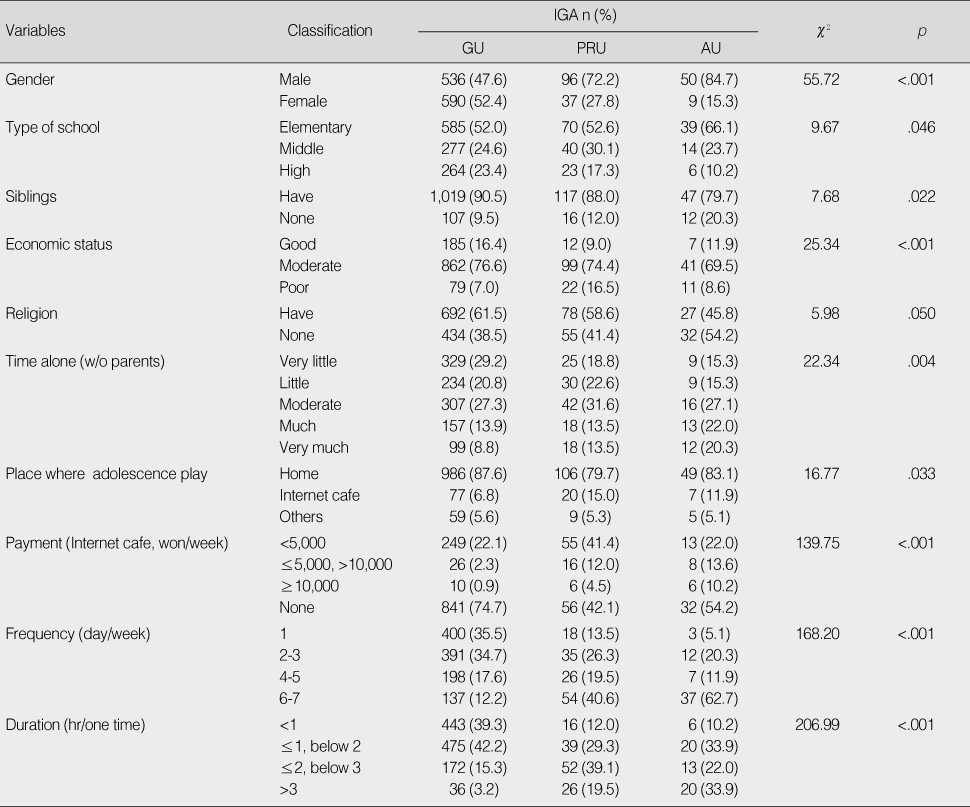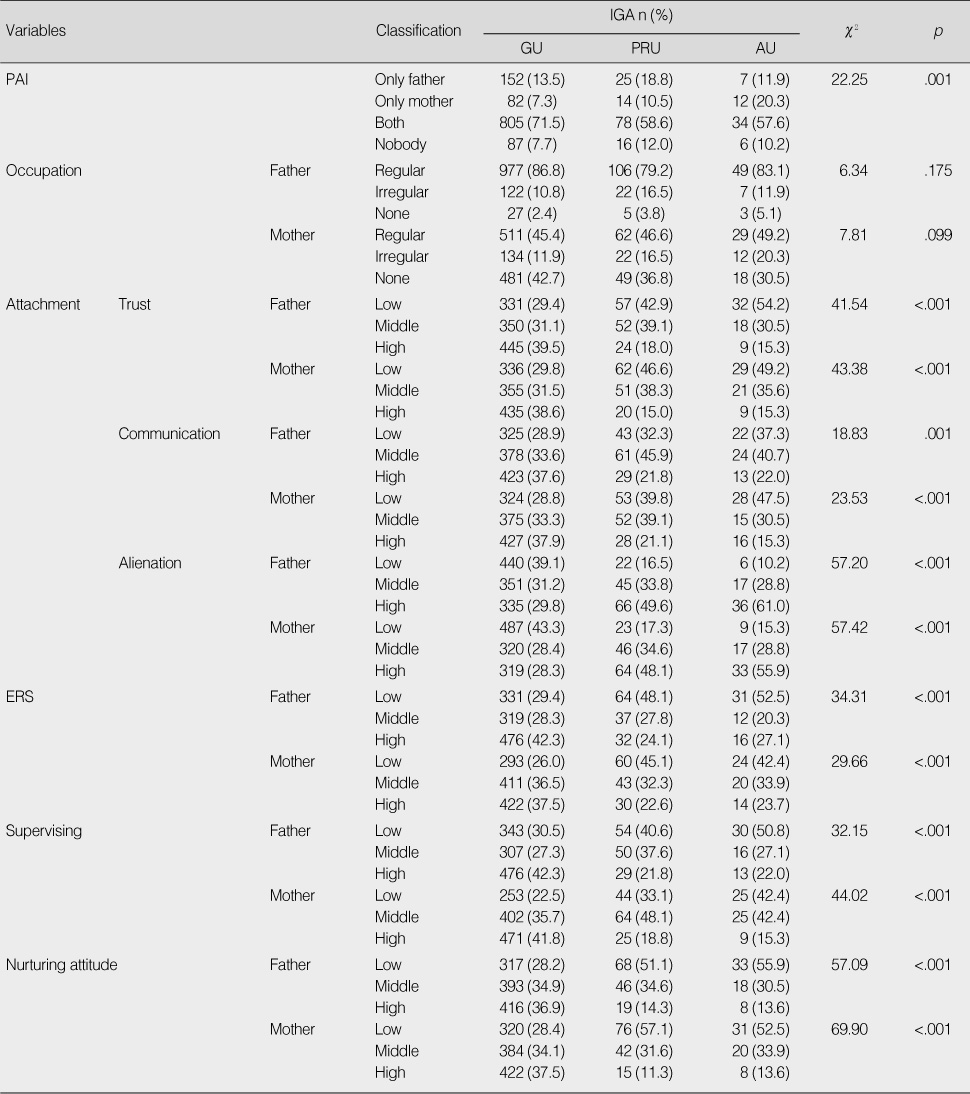Articles
- Page Path
- HOME > J Korean Acad Nurs > Volume 40(3); 2010 > Article
-
Original Article
- A Prediction Model for Internet Game Addiction in Adolescents: Using a Decision Tree Analysis
- Ki Sook Kim, Kyung Hee Kim
-
Journal of Korean Academy of Nursing 2010;40(3):378-388.
DOI: https://doi.org/10.4040/jkan.2010.40.3.378
Published online: June 30, 2010
1Fellow, College of Nursing, Ajou University, Suwon, Korea.
2Professor, Department of Nursing, Chung-Ang University, Seoul, Korea.
- Address reprint requests to: Kim, Kyung Hee. Department of Nursing, Chung-Ang University, 221 Heukseok-dong, Dongjak-gu, Seoul 156-756, Korea. Tel: 82-2-820-5670, Fax: 82-2-824-7961, kyung@cau.ac.kr
Copyright © 2010 Korean Society of Nursing Science
Abstract
-
Purpose
- This study was designed to build a theoretical frame to provide practical help to prevent and manage adolescent internet game addiction by developing a prediction model through a comprehensive analysis of related factors.
-
Methods
- The participants were 1,318 students studying in elementary, middle, and high schools in Seoul and Gyeonggi Province, Korea. Collected data were analyzed using the SPSS program. Decision Tree Analysis using the Clementine program was applied to build an optimum and significant prediction model to predict internet game addiction related to various factors, especially parent related factors.
-
Results
- From the data analyses, the prediction model for factors related to internet game addiction presented with 5 pathways. Causative factors included gender, type of school, siblings, economic status, religion, time spent alone, gaming place, payment to Internet cafe@, frequency, duration, parent's ability to use internet, occupation (mother), trust (father), expectations regarding adolescent's study (mother), supervising (both parents), rearing attitude (both parents).
-
Conclusion
- The results suggest preventive and managerial nursing programs for specific groups by path. Use of this predictive model can expand the role of school nurses, not only in counseling addicted adolescents but also, in developing and carrying out programs with parents and approaching adolescents individually through databases and computer programming.
- 1. Ahn HS, Lee JS. Research of computer game immersion children's characters. Education Development Review. 2002;23:57–87.
- 2. Armsden GC, Greenberg MT. The inventory of parent and peer attachment: Relationships to well-being in adolescence. Journal of Youth Adolescence. 1987;16:427–454.PubMed
- 3. Bowlby J. Attachment and Loss, Vol, I: Attachment. 1969;New York, NY, Basic Books.
- 4. Choi JH, Han ST, Kang HC, Kim ES, Kim MK, Lee SK. Data mining prediction and application. 2002;Seoul, SPSS academy.
- 5. Jang HS. Adolescent-mother conflicts and their related variables. Korean Journal of Developmental Psychology. 2005;18:97–113.
- 6. Jo AM, Bang HJ. The effects of parent, teacher, and friend social support on adolescents game addiction. Korean Journal of Youth Studies. 2003;10:249–275.
- 7. Kheirkhah F, Juibary AG, Gouran A, Hashemi S. Internet addiction prevalence and epidemiological features: First study in Iran. European Psychiatry. 2008;23:309. PubMed
- 8. Kim HJ, Lee SJ, Woo JI, Jo HS, Kweon HJ. The internet using pattern and addiction-relating factor analysis of adolescents in Korea. Journal of the Korean Academy of Family Medicine. 2002;23:334–343.
- 9. Kim KS, Kim KH. Parent related factors in internet game addiction among elementary school students. Journal of Korean Academy of Child Health Nursing. 2009;15:24–33.Article
- 10. Kim SH. Internet Addiction, It can be cure by intensive care camp. Dong-A daily newspaper. 2008;06 16 A11.
- 11. Kim YH. Construction of a model of internet-addicted adolescents mental health. 2006;Seoul, Chung-Ang University. Unpublished doctoral dissertation.
- 12. Kim YH, Son HM, Yang YO, Cho YR, Lee NY. Relation between internet game addiction in elementary school students and student's perception of parent-child attachment. Journal of Korean Academy of Child Health Nursing. 2007;13:383–389.
- 13. Korea Agency for Digital Opportunity & Promotion [KADO]. A study of the development of internet game addiction scale for children and adolescents. 2006;Seoul, Author.
- 14. Korea Agency for Digital Opportunity & Promotion [KADO]. Research of internet addiction family counsel program development. 2007;Seoul, Author.
- 15. Korea Institute of Criminology [KIC]. Home environment and juvenile delinquency. 1995;Seoul, Author.
- 16. Current state of internet use. Korea Internet & Security Agency [KISA]. 2009;Retrieved December 17, 2009. from http://isis.nida.or.kr/sub01/?pageId=010400.
- 17. Kwon JH. The internet game addiction of adolescents: Temporal changes and related psychological variables. Korean Journal of Clinical Psychology. 2005;24:267–280.
- 18. Kwon YH. Construction of internet game addiction predictive model in adolescent. 2005;Daegu, Keimyung University. Unpublished doctoral dissertation.
- 19. Lee HK. Effects of individual- and social-related factors and motives for game playing on game concentration and game addiction. Korean Journal of Youth Studies. 2003;10:355–380.
- 20. Lim EM, Lee SY. Adolescents' computer/internet use and parent-Adolescent conflict. Journal of Educational psychology. 2002;6:243–258.
- 21. Mitchell P. Internet Addiction: Genuine diagnosis or not? The Lancet. 2000;355:632. Article
- 22. Nam SH, Kim YH. Mother's psychological factors and young childrens's internalizing & externalizing malbehaviors. Journal of the Korea Home Economics Association. 2000;38:199–213.
- 23. Ok J. The relationship between attachment security and depression in adolescence: Focusing on the mediating effect of perceived competence. 1998;Seoul, Ewha Womans University. Unpublished master's thesis.
- 24. Rae-Grant N, Thomas BM, Offrod DR, Boyle NM. Risk, protective factors and the prevalence of behavioral and emotional disorders in children and adolescent. Journal of American Academy of Child and Adolescent psychiatry. 1989;28:262–268.
- 25. Rohner RP, Rohner EC. Parental acceptance-rejection and parental control: Cross cultural coders. Ethnology. 1981;20:245–260.Article
- 26. Ryu JA. An analysis of ecological variables affecting adolescent internet addiction. 2003;Seoul, Sookmyung Women's University. Unpublished doctoral dissertation.
- 27. Song SJ, Sim HO. Computer immersion and children's psychosocial/behavioral characteristics. Korean Journal of Child Studies. 2003;24:27–41.
- 28. Suh SY, Lee YH. The relationships between daily hassles, social support, absorption trait and internet addiction. Korean Journal of Clinical Psychology. 2007;26:391–405.Article
REFERENCES

Figure & Data
REFERENCES
Citations

- Lise Öğrencilerinin Problemli İnternet Kullanımı ile Karakter Güçleri ve Akademik Başarı Arasındaki İlişki
Yeşim Saruhan, Muhammet Çiftçi
Mavi Atlas.2025; 13(1): 50. CrossRef - Factors influencing smartphone overdependence among adolescents
Dabok Noh, Mi-So Shim
Scientific Reports.2024;[Epub] CrossRef - Effects of practical hobbies on children’s device usage and media addiction in Korea
Eunjoo Hong, Junho Ryu
Journal of Human Behavior in the Social Environment.2022; 32(6): 812. CrossRef - The effect of internet game behavior monitoring on college students: Focusing on visual feedback
Changmin Keum, Dongil Kim
Current Psychology.2022; 41(6): 3339. CrossRef - From the Hands of an Early Adopter’s Avatar to Virtual Junkyards: Analysis of Virtual Goods’ Lifetime Survival
Kamil Bortko, Patryk Pazura, Juho Hamari, Piotr Bartków, Jarosław Jankowski
Applied Sciences.2019; 9(7): 1268. CrossRef - Development of a Quantitative Model on Adolescent Cyberbullying Victims in Korea: A System Dynamics Approach
Mi Jin You, Eun Mi Ham
Journal of Korean Academy of Nursing.2019; 49(4): 398. CrossRef - Spontaneous Brain Activity Did Not Show the Effect of Violent Video Games on Aggression: A Resting-State fMRI Study
Wei Pan, Xuemei Gao, Shuo Shi, Fuqu Liu, Chao Li
Frontiers in Psychology.2018;[Epub] CrossRef - Factors Influencing VDT syndrome among male adolescents with risk of digital addiction
GyeongAe Seomun, Youngjin Lee
Journal of Digital Convergence.2016; 14(1): 363. CrossRef - Impact of Depression, Ego-resilience, and Active Stress Coping on Internet Addiction Tendency among College Students
Won Oak Oh, Hyunjeong Shin
Journal of Korean Public Health Nursing.2016; 30(1): 56. CrossRef - Computer game misuse and addiction of adolescents in a clinically referred study sample
Jan Frölich, Gerd Lehmkuhl, Helmut Orawa, Michael Bromba, Katharina Wolf, Anja Görtz-Dorten
Computers in Human Behavior.2016; 55: 9. CrossRef - Effects of Stress Coping Behaviors on Higher Grade Elementary School Students’ Internet Game Addiction: Focused on Gender Difference
Young-Hee Ju, So-Hee Lim
Journal of the Korean Society of School Health.2016; 29(3): 226. CrossRef - Gaming and Religion: The Impact of Spirituality and Denomination
Birgit Braun, Johannes Kornhuber, Bernd Lenz
Journal of Religion and Health.2016; 55(4): 1464. CrossRef - The longitudinal effects of influence of parental attachment and emotion regulation on Internet delinquency in early adolescence
Mi-Kyoung Cho, Hee-Young Kim, Sung Seek Moon
Journal of Human Behavior in the Social Environment.2016; 26(7-8): 587. CrossRef - A Study on the Relationship between Self-Esteem, Social Support, Smartphone Dependency, Internet Game Dependency of College Students
Journal of East-West Nursing Research.2015; 21(1): 78. CrossRef - The Influence of Stress of Children on Game Addiction -Focused on Moderating Effect of Family Support-
Na-Ye Kim
Journal of the Korea Society of Computer and Information.2015; 20(2): 209. CrossRef - A Study on the Game Addiction of Children with Domestic Violence Experience
Na-Ye Kim
Journal of the Korea Society of Computer and Information.2015; 20(3): 145. CrossRef - Predictors of Protective Factors for Internet Game Addiction in Middle School Students using Data Mining Decision Tree Analysis
Young-Ran Kweon, Se-Young Kim
Journal of Korean Academy of Psychiatric and Mental Health Nursing.2014; 23(1): 12. CrossRef - Tendencies toward Game Addiction in the Group of Adolescents with Highly-educated Parents
Hee-Ja Kim
The Journal of the Korea Contents Association.2013; 13(3): 184. CrossRef - Development of a Decision Tree Analysis model that predicts recovery from acute brain injury
Hyun Soo OH, Wha Sook SEO
Japan Journal of Nursing Science.2013; 10(1): 89. CrossRef - Length of stay in PACU among surgical patients using data mining technique
Je-Bog Yoo, Hee Jung Jang
Journal of the Korea Academia-Industrial cooperation Society.2013; 14(7): 3400. CrossRef - Low 2D:4D Values Are Associated with Video Game Addiction
Johannes Kornhuber, Eva-Maria Zenses, Bernd Lenz, Christina Stoessel, Polyxeni Bouna-Pyrrou, Florian Rehbein, Sören Kliem, Thomas Mößle, Pablo Branas-Garza
PLoS ONE.2013; 8(11): e79539. CrossRef - Study on the Contexts and Meanings of Adolescents' Addictive Game Play
Gyongran Jeon, Sohei Lim
Journal of Korea Game Society.2012; 12(6): 83. CrossRef - Emotional Competence and Online Game Use in Adolescents
MIA SEO, HEE SUN KANG, SUN-MI CHAE
CIN: Computers, Informatics, Nursing.2012; 30(12): 640. CrossRef

Figure 1
Internet Game Addiction According to General and Internet Game Characteristics (N=1,318)
IGA=Internet game addiction; GU=General user; PRU=Potential risk user; AU=Addicted user.
Internet Game Addiction According to Parents related Factors (N=1,318)
IGA=Internet game addiction; GU=General user; PRU=Potential risk user; AU=Addicted user; PAI=Parent's ability to use Internet; ERS=Expectation regarding adolescent' study.
Accuracy of the Predictive Model for Internet Game Addiction in Adolescence
GU=General user; PRU=Potential risk user; AU=Addicted user.
IGA=Internet game addiction; GU=General user; PRU=Potential risk user; AU=Addicted user.
IGA=Internet game addiction; GU=General user; PRU=Potential risk user; AU=Addicted user; PAI=Parent's ability to use Internet; ERS=Expectation regarding adolescent' study.
GU=General user; PRU=Potential risk user; AU=Addicted user.
 KSNS
KSNS
 E-SUBMISSION
E-SUBMISSION



 Cite
Cite

